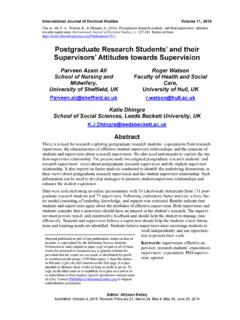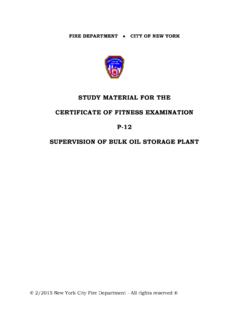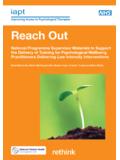Transcription of Basel Committee on Banking Supervision Standards
1 Basel Committee on Banking Supervision Standards Interest rate risk in the Banking book April 2016 This publication is available on the BIS website ( ). Bank for International Settlements 2016. All rights reserved. Brief excerpts may be reproduced or translated provided the source is stated. ISBN 978-92-9197-497-9 (print) ISBN 978-92-9197-498-6 (online) Interest rate risk in the Banking book iii Contents Executive summary .. 1 I. Introduction on IRRBB.
2 3 1. Definition of IRRBB .. 3 2. Credit spread risk in the Banking book (CSRBB) .. 3 3. Economic value and earnings-based measures .. 3 II. The revised IRR Principles .. 4 1. Principles for banks .. 4 2. Principles for supervisors .. 18 III. Scope of application and implementation timeline .. 22 IV. The standardised framework .. 22 1. Overall structure of the standardised framework .. 22 2. Components of the standardised framework .. 23 3. Treatment of NMDs .. 25 4. Treatment of positions with behavioural options other than NMDs.
3 26 5. Automatic interest rate options .. 29 6. Calculation of the standardised EVE risk measure .. 30 Annex 1 .. 32 Annex 2 .. 44 Interest rate risk in the Banking book 1 Executive summary 1. Interest rate risk in the Banking book (IRRBB) is part of the Basel capital framework s Pillar 2 (Supervisory Review Process) and subject to the Committee s guidance set out in the 2004 Principles for the management and Supervision of interest rate risk (henceforth, the IRR Principles).
4 1 The IRR Principles lay out the Committee s expectations for banks identification, measurement, monitoring and control of IRRBB as well as its Supervision . 2. The Committee has decided that the IRR Principles need to be updated to reflect changes in market and supervisory practices since they were first published, and this document contains an updated version that revises both the Principles and the methods expected to be used by banks for measuring, managing, monitoring and controlling such risks.
5 3. These updated Principles were the subject of consultation in 2015, when the Committee presented two options for the regulatory treatments of IRRBB: a standardised Pillar 1 (Minimum Capital Requirements) approach and an enhanced Pillar 2 approach (which also included elements of Pillar 3 Market Discipline).2 The Committee noted the industry s feedback on the feasibility of a Pillar 1 approach to IRRBB, in particular the complexities involved in formulating a standardised measure of IRRBB which would be both sufficiently accurate and risk-sensitive to allow it to act as a means of setting regulatory capital requirements.
6 The Committee concludes that the heterogeneous nature of IRRBB would be more appropriately captured in Pillar 2. 4. Nonetheless, the Committee considers IRRBB to be material, particularly at a time when interest rates may normalise from historically low levels. The key updates to the Principles under an enhanced Pillar 2 approach are as follows: Greater guidance has been provided on the expectations for a bank s IRRBB management process, in particular the development of shock and stress scenarios (Principle 4) to be applied to the measurement of IRRBB, the key behavioural and modelling assumptions which banks should consider in their measurement of IRRBB (Principle 5) and the internal validation process which banks should apply for their internal measurement systems (IMS) and models used for IRRBB (Principle 6)
7 The disclosure requirements under Principle 8 have been updated to promote greater consistency, transparency and comparability in the measurement and management of IRRBB. Banks must disclose, among other requirements, the impact of interest rate shocks on their change in economic value of equity ( EVE) and net interest income ( NII), computed based on a set of prescribed interest rate shock scenarios. The supervisory review process under Principle 11 has been updated to elaborate on the factors which supervisors should consider when assessing the banks level and management of IRRBB exposures.
8 Supervisors could also mandate the banks under their respective jurisdictions to follow the standardised framework for IRRBB (eg if they find that the bank s IMS does not adequately capture IRRBB). The standardised framework has been updated to enhance risk capture. 1 2 2 Interest rate risk in the Banking book Supervisors must publish their criteria for identifying outlier banks under Principle 12. The threshold for the identification of an outlier bank has also been tightened, where the outlier/materiality test(s) applied by supervisors should at least include one which compares the bank s EVE with 15% of its Tier 1 capital, under a set of prescribed interest rate shock scenarios.
9 Supervisors may implement additional outlier/materiality tests with their own specific measures. There is a strong presumption for supervisory and/or regulatory capital consequences, when a review of a bank s IRRBB exposure reveals inadequate management or excessive risk relative to a bank s capital, earnings or general risk profile. 5. Consistent with the scope of application of the Basel II framework, the proposed framework would be applied to large internationally active banks on a consolidated basis.
10 Supervisors have national discretion to apply the IRRBB framework to other non-internationally active 6. The document is structured as follows. Section I provides an introduction to IRRBB. Section II presents the revised Principles, which replace the 2004 IRR Principles for defining supervisory expectations on the management of IRRBB. Principles 1 to 7 are of general application for the management of IRRBB, covering expectations for a bank s IRRBB management process, in particular the need for effective IRRBB identification, measurement, monitoring and control activities.


















